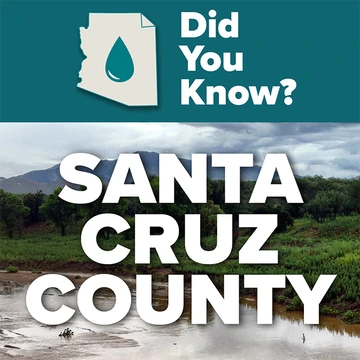Arizona Water Factsheets … Did You Know?
Santa Cruz County Works to Address Water Challenges and Support Ecotourism

With a total area of 1,238 square miles, Santa Cruz County is Arizona’s smallest county and is also one of the most ecologically diverse counties. Located along Mexico’s border in the Sky Island region of Southern Arizona, it harbors some of the last remaining native grasslands in the state. With an average of 18 inches of annual rainfall, Santa Cruz County’s diverse landscape supports more than 7,000 species of plants and animals and includes the headwaters and some of the last perennial reaches of the Santa Cruz River. The county’s economic and environmental profile, which features ecotourism and wine trails, reflects the unique hydrology and binational nature of the Upper Santa Cruz River Basin. Major population centers within the county include Nogales and Rio Rico. Land ownership (54% federal, 8% state, 38% private) shapes how water and land are managed.
In 2009, significant upgrades to the treatment processes at the Nogales International Wastewater Treatment Plant resulted in substantial water quality improvements, the return of more diverse aquatic life to the Santa Cruz River, and greater infiltration to groundwater aquifers. Binational partnerships are exploring solutions to address cross-border flows of contaminated wastewater and stormwater. These efforts, which involve US and Mexican public institutions as well as state and federal agencies, aim to restore local ecosystems and promote healthier, sustainable border cities by developing a green infrastructure network of over 100 sites, including neighborhood parks, schools, and sports facilities in Ambos Nogales.
Despite the water related challenges Santa Cruz County faces, actions are in place to mitigate the impact of a hotter, drier future. The Upper Santa Cruz Watershed is home to multiple organizations and public efforts that are dedicated to restoring and maintaining riparian habitat and sustaining flows on the Santa Cruz River, Sonoita Creek, Harshaw Creek, and other waters. Vital economic and quality of life benefits are derived from investments in nature-based tourism paired with conservation, restoration, and preservation activities in Santa Cruz County. In 2019, this economic strategy supported 779 jobs, $31.1 million in county GDP, and $76.6 million in sales.

